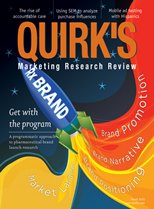Editor’s note: Gail Ritacco is vice president of consumer and market research of Conn.-based brand strategy and design firm Product Ventures. Peter Clarke is the firm’s founder and CEO.
Interest and focus on packaging design has increased in recent years and so has the number of packaging research studies. Here are five tips to give your packaging research the direction required to drive a successful execution to market.
1. Work arm-in-arm with designers and engineers
Too often packaging research is fielded by research generalists and not packaging research specialists. A research generalist may lack the understanding of the subject matter to effectively probe, uncover and obtain actionable insights for packaging. Obvious insights that are often elementary and already known in the industry are more likely to be delivered. It takes interdisciplinary experts in industrial design, graphic design and package engineering working arm-in-arm with package research experts from project inception through final design to ensure the right questions are asked of consumers. Research is planned and orchestrated knowing the realistic packaging possibilities, with tools and techniques to best inform package design. When research is done in this way, more meaningful insights are brought to the table that unlock package design potential and result in a compelling and cost-effective package solution.
2. Put the brand in hand
When grappling with a structural package initiative, one must avoid the enticing convenience of conducting research using only visuals for the screening of design ideas. It is important to let consumers interact with physical packaging prototypes so that viable options aren’t prematurely eliminated based on misperception or strict visual impression. Packaging is a tangible object and its size, feel and functionality can be just as important as its visual communication. You must put the brand in hand by leveraging package design knowledge, ergonomic expertise and prototyping to create a physical package, ensuring nothing is lost in translation.
3. Understand purchase through disposal
Packaging is often evaluated solely from an on-the-shelf perspective. However, packaging has a life cycle that goes beyond the shelf. There are various moments of packaging truth within the consumer experience. With this in mind, consider a variety of tools for use across the various consumer touchpoints, each designed to best obtain consumer insights. Digital ethnographies enable the team to be a fly on the wall in order to observe and probe multiple occasions, package uses and real-life scenarios. In-person contextual interviews can be leveraged with thought-starter packaging stimuli to test packaging possibilities in the real environment it would be used. If tested in a lab, packaging is best understood when consumers are able to experience designs in true-to-life shopping and package use environments, enabling them to fully consider and thoughtfully respond to the packaging possibilities. There isn’t one tool that tells all, so it is important to implement a multifaceted approach to the research process to uncover the full story.
4. Leverage rapid prototyping
Consumer research of package designs does not typically accommodate for on-the-spot modification of a design to confirm the consumers’ packaging needs are being met. Because consumers are reactive and not always creative, they cannot envision and confirm packaging improvements that emerge until they see them brought to life. By harnessing the power of real-time iterative prototyping, you can revolutionize the traditional focus group by rapidly generating new and improved package designs. This enables on-the-spot decision-making for real-time refinement so the team gets it right within the same consumer touchpoint, avoiding the dreaded redundant rounds of research.
5. Bridge the gap between qualitative direction and quantitative validation
In today’s fast-paced world it’s common for overly ambitious research initiatives to embark on a journey with too few or inappropriate consumer check-ins. Oftentimes budget and time constraints can cause packaging researchers to condense the research program to an upfront quantitative screen and/or qualitative research to select one design followed by an expensive shelf-and-use validation test. This can result in misleading design selection. Without posing a substantial threat to the reality of budget and timing, consider quant-qual research. Quant-qual effectively bridges the gap between qualitative research – which should be leveraged for iteration, not selection – and a shelf-and-use test. This can be costly, so the selected designs should have proper optimization before commencement. Using this tool enables consumers to quantitatively indicate preferences to inform selection and then qualitatively express and more deeply explain the reasons behind their ratings and rankings, informing optimization. This level of due diligence ensures you’ll drive a successful package to market.
In today’s fast-moving and competitive marketplace, failure is not an option. When it comes to researching the packaging design possibilities, it is best to go to experts who can effectively address all aspects of your packaging challenge. Employing the expertise that can effectively navigate through the packaging innovation frontier, avoid pitfalls, surmount challenges and elicit meaningful and actionable insights can be the game-changer you need to deliver a consumer-preferred package solution to market.
